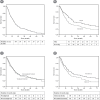Long-term outcomes of surgery in resectable single-station N2 non-small cell lung cancer patients
- PMID: 40575045
- PMCID: PMC12188972
- DOI: 10.5606/tgkdc.dergisi.2025.27229
Long-term outcomes of surgery in resectable single-station N2 non-small cell lung cancer patients
Abstract
Background: This study aims to examine the factors influencing prognosis and long-term survival outcomes in pathological single-station N2 (pN2a) patients undergoing surgical treatment for non-small cell lung cancer.
Methods: Between January 2012 and June 2021, a total of 144 patients (125 males, 19 females; mean age: 60.5±8.4 years; range, 48 to 78 years) who underwent anatomical resection for non-small cell lung cancer and were identified with pN2a disease were retrospectively analyzed. Factors influencing prognosis were analyzed. Survival analysis was performed.
Results: Forty-nine (34%) patients received neoadjuvant therapy and 87 (60.4%) patients underwent lobectomy. In terms of staging, 95 (66%) patients were classified as Stage 3A, while 49 (34%) patients were categorized as Stage 3B. Analysis of N2 subtypes revealed that 77 (53.5%) patients were classified as known N2, whereas 67 (46.5%) patients were identified as incidental. Histopathological evaluation revealed that 58 (40.3%) patients had adenocarcinoma, while 86 (59.7%) patients had non-adenocarcinoma histology. N2 disease was categorized as skip metastasis (pN0N2a) in 61 (42.4%) patients and non-skip metastasis (pN1N2a) in 83 (57.6%) patients. Adjuvant therapy was administered to 126 (87.5%) patients, with treatment modalities determined by the oncology clinics and patient characteristics. Among these, 46 (31.9%) patients received chemotherapy, 15 (10.4%) patients underwent radiotherapy, and 65 (45.1%) patients were treated with chemoradiotherapy. The five-year overall survival rate was 33.9% with a median duration of 37.1±5.0 months. The disease-free survival rate was 24.9% with a median duration of 18.2±2.3 months. Adenocarcinoma histology, non-skip N2 disease, lack of adjuvant therapy, and advanced age (>65 years) were found to be significant factors affecting the prognosis of pN2a disease.
Conclusion: The findings of this study indicate that adenocarcinoma histology, advanced age, absence of adjuvant therapy, and the presence of pN1N2a are significant prognostic factors in pN2a patients undergoing curative resection for non-small cell lung cancer.
Keywords: Adenocarcinoma; adjuvant therapy; elderly; lymph node; non-small cell lung cancer; single station N2; skip N2; surgery..
Copyright © 2025, Turkish Society of Cardiovascular Surgery.
Conflict of interest statement
Conflict of Interest: The authors declared no conflicts of interest with respect to the authorship and/or publication of this article.
Figures


Similar articles
-
A rapid and systematic review of the clinical effectiveness and cost-effectiveness of paclitaxel, docetaxel, gemcitabine and vinorelbine in non-small-cell lung cancer.Health Technol Assess. 2001;5(32):1-195. doi: 10.3310/hta5320. Health Technol Assess. 2001. PMID: 12065068
-
Impact of residual disease as a prognostic factor for survival in women with advanced epithelial ovarian cancer after primary surgery.Cochrane Database Syst Rev. 2022 Sep 26;9(9):CD015048. doi: 10.1002/14651858.CD015048.pub2. Cochrane Database Syst Rev. 2022. PMID: 36161421 Free PMC article.
-
Postoperative adjuvant chemotherapy in rectal cancer operated for cure.Cochrane Database Syst Rev. 2012 Mar 14;2012(3):CD004078. doi: 10.1002/14651858.CD004078.pub2. Cochrane Database Syst Rev. 2012. PMID: 22419291 Free PMC article.
-
Cost-effectiveness of using prognostic information to select women with breast cancer for adjuvant systemic therapy.Health Technol Assess. 2006 Sep;10(34):iii-iv, ix-xi, 1-204. doi: 10.3310/hta10340. Health Technol Assess. 2006. PMID: 16959170
-
Does Augmenting Irradiated Autografts With Free Vascularized Fibula Graft in Patients With Bone Loss From a Malignant Tumor Achieve Union, Function, and Complication Rate Comparably to Patients Without Bone Loss and Augmentation When Reconstructing Intercalary Resections in the Lower Extremity?Clin Orthop Relat Res. 2025 Jun 26. doi: 10.1097/CORR.0000000000003599. Online ahead of print. Clin Orthop Relat Res. 2025. PMID: 40569278
References
-
- Klastersky J, Burkes R, Choi N, Dombernowsky P, Darwish S, Ginsberg RJ, et al. Induction therapy for NSCLC: a consensus report. Lung Cancer. 1991;7:15–17. doi: 10.1016/0169-5002(91)90006-R. - DOI
-
- Wang M, Zhang Y, Liu M, Wang Y, Niu X, Qiu D, et al. Exploration of a novel prognostic model based on nomogram in non-small cell lung cancer patients with distant organ metastasis: Implications for immunotherapy. Transl Lung Cancer Res. 2023;12:2040–2054. doi: 10.21037/tlcr-23-480. - DOI - PMC - PubMed
-
- Yu L, Zhang Z, Yi H, Wang J, Li J, Wang X, et al. A PET/ CT radiomics model for predicting distant metastasis in early-stage non-small cell lung cancer patients treated with stereotactic body radiotherapy: A multicentric study. Radiat Oncol. 2024;19:10–10. doi: 10.1186/s13014-024-02402-z. - DOI - PMC - PubMed
LinkOut - more resources
Full Text Sources
